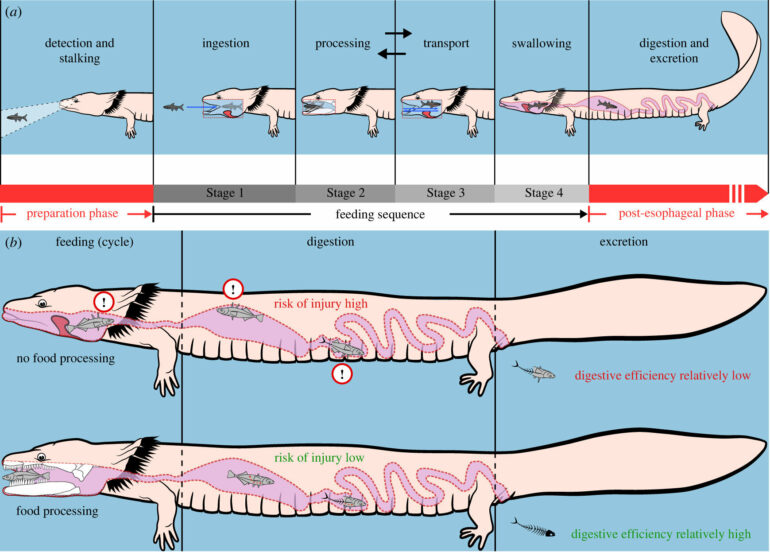Since the work of Charles Darwin, it is relatively clear from an evolutionary perspective where we come from: aquatic ancestors gave rise to terrestrial vertebrates, from among which humans developed.
However, it has not yet been clarified how exactly the vertebrate water-to-land transition took place despite physical and physiological constraints that the life under the new terrestrial condition brought about. The vertebrate water-to-land transition began about 360 million years ago in the Devonian period. Feeding was one of the most essential processes that early tetrapods had to adapt during the change from aquatic to terrestrial life.
An international team led by Dr. Daniel Schwarz and Prof. Dr. Rainer Schoch of the State Museum of Natural History Stuttgart, Germany, studied the feeding behavior of extant salamanders and subsequently used the results of these analyses to draw conclusions about the feeding behavior of early tetrapods. The research results suggest that early terrestrial vertebrates may have eaten during their first attempts to conquer the land despite lacking mobile tongues like those seen across many of today’s amniotes.
In addition, during the early stages of development when they were still aquatic, early tetrapods may have performed complex chewing behaviors similar to mammals despite often possessing relatively simple shaped teeth (curved-conical and monocuspid). The research was published in Philosophical Transactions of the Royal Society B: Biological Sciences.
The researchers chose an experimental biological approach to clarify the feeding behavior of early tetrapods. They studied and observed recent salamanders because they display similar anatomies and can feed in water and on land. The scientists analyzed the feeding behavior of forty species from nine of the ten salamander families during three developmental stages, making this the most comprehensive salamander feeding study to date.
“We observed the animals as larvae, juveniles before metamorphosis, and adults after metamorphosis. After metamorphosis, the salamanders were observed during feeding, if possible, both underwater and on land. Our study stands out from previous studies not only because of the number of species and the developmental approach but also because feeding was studied from the initial intake of food into the mouth to the onset of swallowing”, said Dr. Daniel Schwarz.
Possible changes in the feeding behavior of prehistoric animals were studied with modern technologies: Developmental water-land transitions in salamanders were used to model possible changes in the feeding behavior of early tetrapods. Detailed analyses were partly possible through modern technologies, such as high-speed X-ray video imaging, from two perspectives, which were used to generate three-dimensional animations (XROMM).
This method allows for studying the rapid movements of bone structures used during feeding as well as the movements of prey in the salamanders’ mouths. X-ray videography enabled looking into the mouths of the animals, even when they were closed.
Two possible scenarios for early terrestrial feeding
The researchers’ data suggest two scenarios for terrestrial feeding in early tetrapods: either prey was grasped with the jaws and dragged back into the water, where the tongue may have transported it via water currents and the jaws may have processed it (chewing bites)—or prey was processed directly on land by a combination of prey shaking and biting, and finally swallowed with the help of inertial transport (i.e., quick forward movements or head rotations while temporarily releasing the grip on the food).
Therefore, it seems that terrestrial feeding was possible even before vertebrates walked on land and before flexible tongues evolved. Further, the observations suggest the presence of complex chewing habits, including jaw movements in more than one dimension, during early developmental stages.
“The present work can be seen as important foundational research from which further questions may arise. In further studies, we would like to investigate the skulls, jaws, and tongue structures of early terrestrial vertebrates based on fossils to clarify additive details regarding the evolution of the feeding behavior of early tetrapods and the water-land transition of vertebrates,” say the scientists Dr. Daniel Schwarz and Prof. Dr. Rainer Schoch.
More information:
Daniel Schwarz et al, Using salamanders as model taxa to understand vertebrate feeding constraints during the late Devonian water-to-land transition, Philosophical Transactions of the Royal Society B: Biological Sciences (2023). DOI: 10.1098/rstb.2022.0541
Provided by
State Museum of Natural History Stuttgart
Citation:
Study of modern salamanders provides clues to the feeding behavior of early terrestrial vertebrates (2023, October 18)
